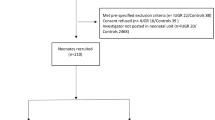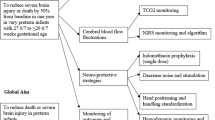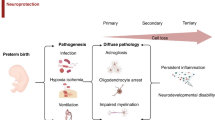Abstract
Background:
Fetal growth restriction is the second leading cause of perinatal morbidity and mortality, and neonates with intrauterine growth retardation (IUGR) have increased neurocognitive and neuropsychiatric morbidity. These neurocognitive impairments are mainly related to injury of the developing brain associated with IUGR. Growing evidence from preclinical models of brain injury in both adult and neonatal rodents supports the view that nitric oxide can promote neuroprotection.
Methods:
In a model of IUGR induced by protracted gestational hypoxia leading to diffuse white matter injury, we subjected neonatal rats to low dose (5 ppm) but long-lasting (7 d) exposure to inhaled NO (iNO). We used a combination of techniques, including immunohistochemistry, quantitative PCR, and cognitive assessment, to assess neuroprotection.
Results:
Antenatal hypoxia-induced IUGR was associated with severe neuroinflammation and delayed myelination. iNO exposure during the first postnatal week significantly attenuated cell death and microglial activation, enhanced oligodendroglial proliferation and finally improved myelination. Remarkably, iNO was associated with the specific upregulation of P27kip1, which initiates oligodendrocytic differentiation. Finally, iNO counteracted the deleterious effects of hypoxia on learning abilities.
Conclusion:
This study provides new evidence that iNO could be effective in preventing brain damage and/or enhancing repair of the developing brain.
Similar content being viewed by others
Log in or create a free account to read this content
Gain free access to this article, as well as selected content from this journal and more on nature.com
or
References
Gabbe SG, Niebyl JR, Simpson JL, et al. Intrauterine growth restriction. In: Gabbe SG, Niebyl JR, Simpson JL, et al, eds. Obstetrics: Normal and Problem Pregnancies. 3rd edn. New York: Churchill Livingstone, 1996:863–86.
Neerhof MG . Causes of intrauterine growth restriction. Clin Perinatol 1995;22:375–85.
Hack M, Flannery DJ, Schluchter M, Cartar L, Borawski E, Klein N . Outcomes in young adulthood for very-low-birth-weight infants. N Engl J Med 2002;346:149–57.
Ozanne SE, Fernandez-Twinn D, Hales CN . Fetal growth and adult diseases. Semin Perinatol 2004;28:81–7.
Jarvis S, Glinianaia SV, Torrioli MG, et al.; Surveillance of Cerebral Palsy in Europe (SCPE) collaboration of European Cerebral Palsy Registers. Cerebral palsy and intrauterine growth in single births: European collaborative study. Lancet 2003;362:1106–11.
O’Keeffe MJ, O’Callaghan M, Williams GM, Najman JM, Bor W . Learning, cognitive, and attentional problems in adolescents born small for gestational age. Pediatrics 2003;112:301–7.
Geva R, Eshel R, Leitner Y, Fattal-Valevski A, Harel S . Memory functions of children born with asymmetric intrauterine growth restriction. Brain Res 2006;1117:186–94.
Wiles NJ, Peters TJ, Heron J, Gunnell D, Emond A, Lewis G . Fetal growth and childhood behavioral problems: results from the ALSPAC cohort. Am J Epidemiol 2006;163:829–37.
Cannon M, Jones PB, Murray RM . Obstetric complications and schizophrenia: historical and meta-analytic review. Am J Psychiatry 2002;159:1080–92.
Isaacs EB, Lucas A, Chong WK, et al. Hippocampal volume and everyday memory in children of very low birth weight. Pediatr Res 2000;47:713–20.
Ferriero DM . Neonatal brain injury. N Engl J Med 2004;351:1985–95.
Volpe JJ . Brain injury in premature infants: a complex amalgam of destructive and developmental disturbances. Lancet Neurol 2009;8:110–24.
Batalle D, Eixarch E, Figueras F, et al. Altered small-world topology of structural brain networks in infants with intrauterine growth restriction and its association with later neurodevelopmental outcome. Neuroimage 2012;60:1352–66.
Olivier P, Loron G, Fontaine RH, et al. Nitric oxide plays a key role in myelination in the developing brain. J Neuropathol Exp Neurol 2010;69:828–37.
Pansiot J, Loron G, Olivier P, et al. Neuroprotective effect of inhaled nitric oxide on excitotoxic-induced brain damage in neonatal rat. PLoS One 2010;5:e10916.
Charriaut-Marlangue C, Bonnin P, Gharib A, et al. Inhaled nitric oxide reduces brain damage by collateral recruitment in a neonatal stroke model. Stroke 2012;43:3078–84.
Charriaut-Marlangue C, Bonnin P, Pham H, et al. Nitric oxide signaling in the brain: a new target for inhaled nitric oxide? Ann Neurol 2013;73:442–8.
Pham H, Vottier G, Pansiot J, et al. Inhaled NO prevents hyperoxia-induced white matter damage in neonatal rats. Exp Neurol 2014;252:114–23.
Terpolilli NA, Kim SW, Thal SC, et al. Inhalation of nitric oxide prevents ischemic brain damage in experimental stroke by selective dilatation of collateral arterioles. Circ Res 2012;110:727–38.
Terpolilli NA, Kim SW, Thal SC, Kuebler WM, Plesnila N . Inhaled nitric oxide reduces secondary brain damage after traumatic brain injury in mice. J Cereb Blood Flow Metab 2013;33:311–8.
Terpolilli NA, Moskowitz MA, Plesnila N . Nitric oxide: considerations for the treatment of ischemic stroke. J Cereb Blood Flow Metab 2012;32:1332–46.
Li YS, Shemmer B, Stone E, A Nardi M, Jonas S, Quartermain D . Neuroprotection by inhaled nitric oxide in a murine stroke model is concentration and duration dependent. Brain Res 2013;1507:134–45.
Baud O, Daire JL, Dalmaz Y, et al. Gestational hypoxia induces white matter damage in neonatal rats: a new model of periventricular leukomalacia. Brain Pathol 2004;14:1–10.
Haynes RL, Billiards SS, Borenstein NS, Volpe JJ, Kinney HC . Diffuse axonal injury in periventricular leukomalacia as determined by apoptotic marker fractin. Pediatr Res 2008;63:656–61.
Rees S, Harding R, Walker D . The biological basis of injury and neuroprotection in the fetal and neonatal brain. Int J Dev Neurosci 2011;29:551–63.
Johnston MV . Clinical disorders of brain plasticity. Brain Dev 2004;26:73–80.
McElrath TF, Allred EN, Van Marter L, Fichorova RN, Leviton A ; ELGAN Study Investigators. Perinatal systemic inflammatory responses of growth-restricted preterm newborns. Acta Paediatr 2013;102:e439–42.
Leviton A, Fichorova RN, O’Shea TM, et al.; ELGAN Study Investigators. Two-hit model of brain damage in the very preterm newborn: small for gestational age and postnatal systemic inflammation. Pediatr Res 2013;73:362–70.
Hagberg H, Gressens P, Mallard C . Inflammation during fetal and neonatal life: implications for neurologic and neuropsychiatric disease in children and adults. Ann Neurol 2012;71:444–57.
Buser JR, Maire J, Riddle A, et al. Arrested preoligodendrocyte maturation contributes to myelination failure in premature infants. Ann Neurol 2012;71:93–109.
Segovia KN, McClure M, Moravec M, et al. Arrested oligodendrocyte lineage maturation in chronic perinatal white matter injury. Ann Neurol 2008;63:520–30.
Yuen TJ, Silbereis JC, Griveau A, et al. Oligodendrocyte-encoded HIF function couples postnatal myelination and white matter angiogenesis. Cell 2014;158:383–96.
Chhor V, Schang AL, Favrais G, Fleiss B, Gressens P . [Long-term cerebral effects of perinatal inflammation]. Arch Pediatr 2012;19:946–52.
Iadecola C . Bright and dark sides of nitric oxide in ischemic brain injury. Trends Neurosci 1997;20:132–9.
Chen W, Qi J, Feng F, et al. Neuroprotective effect of allicin against traumatic brain injury via Akt/endothelial nitric oxide synthase pathway-mediated anti-inflammatory and anti-oxidative activities. Neurochem Int 2014;68:28–37.
Amarenco P, Bogousslavsky J, Callahan A 3rd, et al.; Stroke Prevention by Aggressive Reduction in Cholesterol Levels (SPARCL) Investigators. High-dose atorvastatin after stroke or transient ischemic attack. N Engl J Med 2006;355:549–59.
Charriaut-Marlangue C, Nguyen T, Bonnin P, et al. Sildenafil mediates blood-flow redistribution and neuroprotection after neonatal hypoxia-ischemia. Stroke 2014;45:850–6.
Fontaine RH, Olivier P, Massonneau V, et al. Vulnerability of white matter towards antenatal hypoxia is linked to a species-dependent regulation of glutamate receptor subunits. Proc Natl Acad Sci USA 2008;105:16779–84.
Bouslama M, Durand E, Chauvière L, Van den Bergh O, Gallego J . Olfactory classical conditioning in newborn mice. Behav Brain Res 2005;161:102–6.
Author information
Authors and Affiliations
Corresponding author
Supplementary information
Supplementary Figure S1
(JPEG 838 kb)
Supplementary Figure S2
(JPEG 804 kb)
Supplementary Figure S3
(JPEG 2208 kb)
Supplementary Tables
(DOC 45 kb)
Rights and permissions
About this article
Cite this article
Pham, H., Duy, A., Pansiot, J. et al. Impact of inhaled nitric oxide on white matter damage in growth-restricted neonatal rats. Pediatr Res 77, 563–569 (2015). https://doi.org/10.1038/pr.2015.4
Received:
Accepted:
Published:
Issue date:
DOI: https://doi.org/10.1038/pr.2015.4
This article is cited by
-
Prenatal administration of IL-1Ra attenuate the neurodevelopmental impacts following non-pathogenic inflammation during pregnancy
Scientific Reports (2021)
-
Combination of human endothelial colony-forming cells and mesenchymal stromal cells exert neuroprotective effects in the growth-restricted newborn
npj Regenerative Medicine (2021)
-
Nitric oxide and the brain. Part 2: Effects following neonatal brain injury—friend or foe?
Pediatric Research (2021)
-
Neurovascular effects of umbilical cord blood-derived stem cells in growth-restricted newborn lambs
Stem Cell Research & Therapy (2020)
-
Neuropathology in intrauterine growth restricted newborn piglets is associated with glial activation and proinflammatory status in the brain
Journal of Neuroinflammation (2019)



